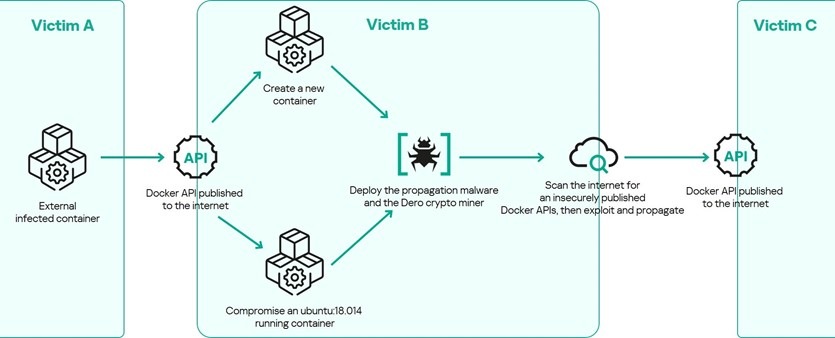Kaspersky Security Services experts have identified a sophisticated cyberattack campaign targeting containerized environments to deploy a miner for the Dero cryptocurrency. The attackers abuse exposed Docker APIs — parts of Docker, an open-source container development platform. In 2025, there are a significant number of Docker API default ports that are insecurely published, accounting for almost 500 occurrences worldwide on average each month. In the discovered campaign, cybercriminals inject two types of malwares into the compromised systems: one is the miner itself and the other is a propagation malware that can spread the campaign to other insecure container networks.
Kaspersky experts discovered this malicious campaign as part of a compromise assessment project. According to expert estimates, any organization that operates containerized infrastructure — while exposing Docker APIs without robust security controls — can be a potential target. These may include technology companies, software development firms, hosting providers, cloud service providers and more enterprises.
According to Shodan, in 2025, there
are 485 published Docker API default ports[1] worldwide
each month on average. This figure illustrates the campaign’s potential attack
surface by tallying the “entry points” — or insecurely exposed ports that
attackers might target. China accounted for the largest average number monthly
— nearly 138 occurrences — followed by Germany (97), the U.S. (58), Brazil (16),
and Singapore (13).
Once attackers identify an insecurely published Docker API, they either compromise existing containers or create new malicious ones based on a legitimate standard Ubuntu image. They then inject two malware types into the compromised containers: “nginx” and “cloud”. The latter is a Dero cryptocurrency miner, while “nginx” is a malicious software that maintains persistence, ensures execution of the miner and scans for other exposed environments. This malware allows attackers to operate without traditional Command-and-Control (C2) servers; instead, each infected container independently scans the internet and can spread the miner to new targets.

An infection chain scheme
“This demonstrates that the
campaign has the potential for exponential growth of infections, with each
compromised container acting as a new source of attack, if security measures
are not immediately put in place in the potentially targeted networks,”
explains Amged Wageh, an incident response and a compromise assessment expert
at Kaspersky Security Services. “Сontainers are foundational to
software development, deployment, and scalability. Their widespread use across
cloud-native environments, DevOps, and microservices architectures makes them
an attractive target for cyber attackers. This growing reliance demands
organizations adopt a 360-degree approach to security — combining robust
security solutions with proactive threat hunting and regular compromise
assessments”.
The attackers embedded the names “nginx” and “cloud” directly in the binary — an inflexible executable file composed of instructions and data for the processor, not for humans. This is a classic masquerading tactic that lets the payload pose as a legitimate tool, trying to deceive both analysts and automated defenses.
The full technical analysis is available on Securelist. Kaspersky products detect these malicious implants with the following verdicts: Trojan.Linux.Agent.gen and RiskTool.Linux.Miner.gen.
To mitigate against container-related threats, Kaspersky recommends:
- Companies that use Docker APIs should immediately review the security of any potentially exposed infrastructure — specifically, refrain from publishing the Docker APIs unless there is an operational need and consider securing the published Docker APIs via TLS.
- Uncover active cyberattacks and previous unknown attacks that flew under the radar with Kaspersky Compromise Assessment.
- Containerization is the most popular application development method at the moment. But risks can emerge in each component of a container’s infrastructure and may heavily impact business processes. The protection of containerized environments is crucial and requires specialized security solutions.Kaspersky Container Security provides security for all stages of containerized application development. Besides the development process, the solution protects runtime, for example, it controls the launch of only trusted containers, the operation of the applications and services inside the containers and monitors the traffic.
- Adopt
managed security services by Kaspersky such asCompromise Assessment,Managed Detection and Response (MDR) and /
or Incident Response, covering the
entire incident management cycle – from threat identification to continuous
protection and remediation. They help to protect against evasive
cyberattacks, investigate incidents and get additional expertise even if a
company lacks cybersecurity workers.
The Security Services
Delivering hundreds of information security projects every year for Fortune 500 organizations worldwide: incident response, managed detection, SOC consulting, red teaming, penetration testing, application security, digital risks protection.
[1] Analysis includes insecurely published Docker’s default API port 2375




